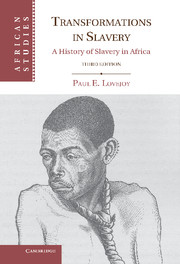Book contents
- Frontmatter
- Contents
- Maps and Tables
- Note on Currencies, Weights, and Measures
- Preface
- Preface to the Second Edition
- Preface to the Third Edition
- 1 Africa and Slavery
- 2 On the Frontiers of Islam, 1400–1600
- 3 The Export Trade in Slaves, 1600–1800
- 4 The Enslavement of Africans, 1600–1800
- 5 The Organization of Slave Marketing, 1600–1800
- 6 Relationships of Dependency, 1600–1800
- 7 The Nineteenth-Century Slave Trade
- 8 Slavery and “Legitimate Trade” on the West African Coast
- 9 Slavery in the Savanna during the Era of the Jihads
- 10 Slavery in Central, Southern, and Eastern Africa in the Nineteenth Century
- 11 The Abolitionist Impulse
- 12 Slavery in the Political Economy of Africa
- Epilogue
- Appendix Chronology of Measures against Slavery
- Notes
- Select Bibliography
- Index
- Books in this series
Epilogue
Published online by Cambridge University Press: 05 June 2012
- Frontmatter
- Contents
- Maps and Tables
- Note on Currencies, Weights, and Measures
- Preface
- Preface to the Second Edition
- Preface to the Third Edition
- 1 Africa and Slavery
- 2 On the Frontiers of Islam, 1400–1600
- 3 The Export Trade in Slaves, 1600–1800
- 4 The Enslavement of Africans, 1600–1800
- 5 The Organization of Slave Marketing, 1600–1800
- 6 Relationships of Dependency, 1600–1800
- 7 The Nineteenth-Century Slave Trade
- 8 Slavery and “Legitimate Trade” on the West African Coast
- 9 Slavery in the Savanna during the Era of the Jihads
- 10 Slavery in Central, Southern, and Eastern Africa in the Nineteenth Century
- 11 The Abolitionist Impulse
- 12 Slavery in the Political Economy of Africa
- Epilogue
- Appendix Chronology of Measures against Slavery
- Notes
- Select Bibliography
- Index
- Books in this series
Summary
The transformations in slavery that have been examined in this book have highlighted the centrality of historical change in Africa. It has been argued that the transformations were in response to external influence, both from the Atlantic world and from the countries of Islam, as well as the internal dynamics of African societies. In emphasizing “transformations,” this study has demonstrated the pervasiveness of slavery in African history and the significance of the transition that occurred under colonialism. As argued, the idea of this centrality can be encapsulated in the concept of “mode of production” that places enslavement, the trade in slaves, and the use of slaves in productive activities in articulation with each other. The significance of ending institutionalized enslavement and trade under colonialism is thereby highlighted. Slavery was not abolished outright but rather allowed to disappear gradually through the criminalization of enslavement and trafficking in humans, but not the emancipation of slaves. Those born under colonial rule were declared to be born free. Hence slavery was undermined as an institution; the “mode of production” linking enslavement, slave trading, and the use of slaves was broken. Although colonial officials referred to the “natural” death of the institution, slavery did not end.
Historically, intercontinental slavery was transformative in the countries and places that received enslaved Africans, both the Americas and the Islamic world. In the Atlantic world, slavery became the basis of a labor system associated with European expansion and colonization. It can be said that slavery was a means of peopling new lands that were being developed as colonies of European imperialism. In this sense, enslavement and transport brought Africans into a colonial world, albeit in almost all cases outside of Africa. The transformations of slavery in Africa evolved as a form of colonialism, in which enslaved Africans become the population of the European colonies of the Americas.
- Type
- Chapter
- Information
- Transformations in SlaveryA History of Slavery in Africa, pp. 281 - 284Publisher: Cambridge University PressPrint publication year: 2011

